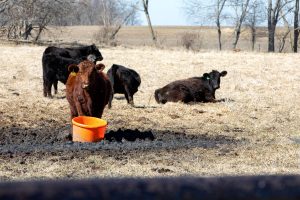Demand for beef, pork expected to grow
By Daniel Grant FarmWeek — October 16, 2022
Cattle graze in a Moultrie County pasture. (File photo by Illinois Farm Bureau photographer Catrina Rawson)
Jeff Simmons, president and CEO of Elanco Animal Health, believes plant-based meat will have its place in the market for years to come.
But it certainly doesn’t appear to be a major threat to the livestock industry at the checkout aisle.
Simmons projects worldwide demand for animal protein will continue to grow. And, he believes the livestock industry is poised to help address some of the world’s top challenges, including hunger.
“The three big issues right now are food insecurity, a global health crisis and climate,” Simmons said during the Agri-Pulse Ag Outlook Forum in Kansas City on Sept. 26. “Animals are connected to all three. I believe they’re the missing piece to some of the world’s biggest problems right now.”
About 60 percent of consumers around the world aren’t getting enough calories, leading to food insecurity, or they’re getting the wrong calories, which is contributing to health issues, according to Simmons.
Boosting animal protein output addresses both those issues by reducing food insecurity and increasing the availability of healthy protein choices.
“Animal protein is one of the hottest food segments the last three years, with 50 percent growth the last 10 years,” Simmons said. “You can’t disconnect consumer choice, calories or the climate.”
Sales of plant-based meat, conversely, could stay flat through 2022 and remain about 1 percent of the total protein market through 2027, according to Simmons.
Top consumer preferences when choosing their protein include taste, cost and nutrition, he noted.
“Consumers are starting to vote (at the food checkout lane),” Simmons said. “Meat is on demand.”
Erin Borror, vice president of economic analysis for the U.S. Meat Export Federation, noted U.S. beef and pork exports reached a record $18.7 billion in 2021 and could push $20 billion this year.
“Beef exports have surpassed $1 billion six of the last seven months. It really has been demand driven,” Borror said. “We have lots of opportunities.”
The U.S. could see even stronger demand for red meat as the world’s top exporter of pork, the European Union, is projected to reduce output this year by nearly 5 percent due to disease outbreaks in its herd and policy to reduce animal numbers on farms.
“It’s critical to have a diverse export base,” said Borror, who noted U.S. farmers must be proactive to maintain their premier animal health status. “That’s part of what continues to offer us opportunities as we look ahead.”
Simmons also views climate challenges as an opportunity for the livestock industry.
“With a carbon market, it increases opportunities for ag,” he said. “Climate-neutral cattle farms are achievable by 2030.”
But to get there, he said farmers must do more than tell their story.
“We need action plans on farms,” he said. “Climate-neutral farming can happen. I see us changing the game.”
This story was distributed through a cooperative project between Illinois Farm Bureau and the Illinois Press Association. For more food and farming news, visit FarmWeekNow.com.







